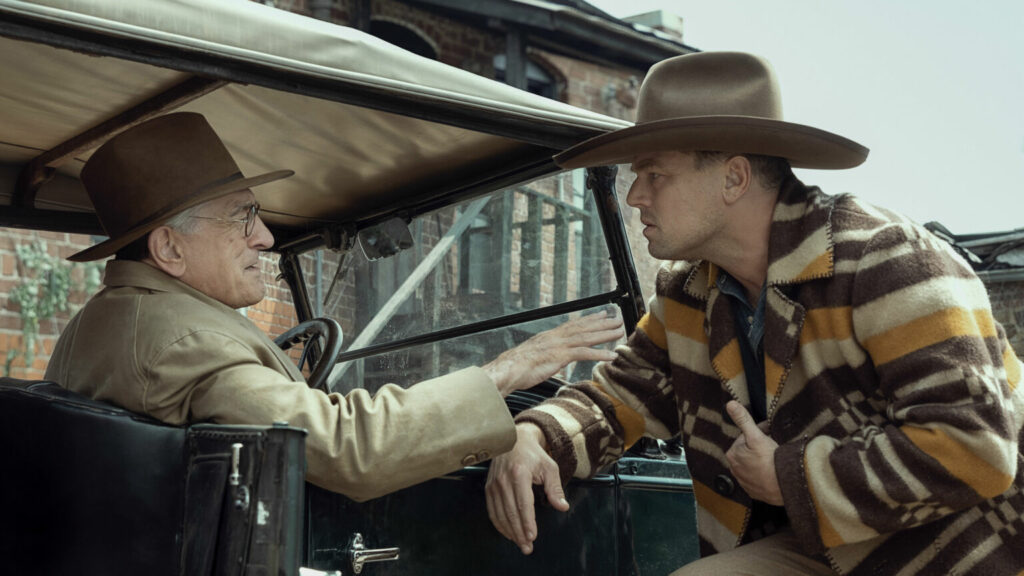Directed by Martin Scorsese | Written by Scorcese and Eric Roth, based on a book by David Grann | 206 min | ▲▲▲▲△
It’s finally here, the much buzzed-about epic (in scope and length) crime drama/western from Martin Scorsese. The film based on the true story of the Osage, a Native American community who in Oklahoma in the 1920s got rich on oil found on their land, and the white people who murdered many of them in order to secure their land titles.
Of course, it’s not quite as straightforward as all that. We’ve got Ernest Burkhart (Leonardo DiCaprio), a none-too-bright war vet returning to Oklahoma to find work with his uncle, William “King” Hale (Robert De Niro), a successful businessman in Fairfax. Ernest does what his uncle tells him to do, though on his own he’s sweet on Mollie Kyle (Lily Gladstone), an Osage woman from one of the wealthy local families who Ernest chauffeurs around town. Even though he’s nobody’s idea of a dream date, Mollie does start to take an interest in Ernest, and that suits King Hale who’s machinating for power and control against the Osage every chance he gets, while on the surface pretends he’s their friend. This as Native Americans die.
Surrounding them are a sprawling cast of white and indigenous characters. As the Osage we have the always impressive Tantoo Cardinal as Mollie’s mother, and Cara Jade Myers, Jillian Dion, and Janae Collins as Mollie’s sisters, all terrific. Amongst the many white men, Scorsese casts a lot of musicians — roles for Jason Isbell, Sturgill Simpson, Charlie Musselwhite, Pete Yorn, and even a cameo from Jack White. We also get a few moments with Jesse Plemons, John Lithgow, and Brendan Fraser, whose mugs are convincingly old school for this kind of a picture.
And what a gorgeous picture it is. Scorsese puts the rumoured $200 million budget up on the screen with a compelling series of wide shots, lots of pulling back to take in the scenes of cars racing in Fairfax and scaring the horses, people dancing at weddings, and fields of spring flowers. In places it has the feel of Coppola’s The Godfather in its ambitions. We also get plenty of dark, matter-of-fact scenes of violence, the grim mundanity of lives taken in the woods, their bodies dumped in the mud.
As Ernest gets more involved in his uncle’s dealings, connecting with the lowlifes in town to do his dirty work, we start to understand how pliable this guy is. He’s a difficult character to be in the centre of this picture. At no point is he sympathetic — and, let’s face it, DiCaprio has made it his mission since Titanic or Catch Me If You Can to play deeply compromised, mostly unlikeable men. It makes me wonder if he could ever play someone warm, even debonair — and, no, I don’t count Great Gatsby. His dental work and Sling Blade underbite here doesn’t help at all, and while I see him reaching for what Jack Nicholson did effortlessly in middle age in movies like The Border and The Crossing Guard, Nicholson found the weakness in his characters while he somehow still kept us rooting for them. With DiCaprio I almost always see him acting weak and don’t much care. But Scorcese’s gift with story kept me compelled.
As DiCaprio’s frequent scene partner, Gladstone is amazing. The wit and wisdom in her character evident when she’s with her sisters but otherwise her stillness is the centre the film rests upon. She spends much of the second half sick in bed without much in the way of agency, and we miss her accordingly.
A nod of the cap to Robbie Robertson, whose score a big part of what works here, his slide guitar instrumentals a unifying element, with Blind Willie Johnson’s “Dark Was The Night, Cold Was The Ground” both an implicit and explicit influence, as much as it was with Ry Cooder’s score to Paris, Texas. The film isn’t without a mordant humour, especially in scenes featuring DiCaprio and De Niro, the cunning uncle frequently berating his dumbass nephew for screwing things up.
Does the film justify its three-and-a-half-hour running time? I didn’t find it a chore, but I could easily point to scenes that could’ve been contracted or left on the cutting room floor altogether. I think it benefits from the big screen, but audiences at home will probably also appreciate watching it in segments when it arrives on Apple TV+
I wondered about choices like having Cardinal’s character, the mother, connect strongly with one of her daughters more than the others, one who subsequently dies and we never see the mother’s reaction. Also, Ernest manages to find a sliver of redemption through his love of his family, his kids. But do we ever see him with them in any fatherly way? No.
All that said, this is a substantial, impressive work — once again in his movies exploring greed and avarice amongst men lacking in anything like empathy — from the 80-year-old Scorsese. It’s a major improvement over The Irishman, which was even more hobbled by its length and de-aging effects that never really worked.
Killers Of The Flower Moon is also about as sensitive and elegant telling of this tale we could get from a white, settler filmmaker — Scorsese has done his homework and this feels respectful to the Osage and honest about how white men have exploited the Native Americans at every turn. In the film’s final few moments, Scorsese uses a technique to remind us he’s the one behind the film that’s about as graceful as any I could imagine.
You watch: when Oscar comes calling next year, and it will, it’ll be Christopher Nolan versus Martin Scorcese in the battle of The Sins of American Men historical epics.

















